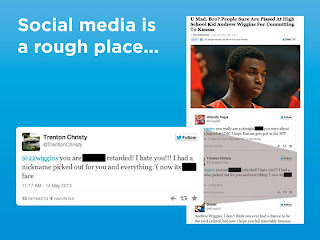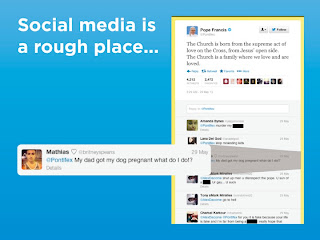Seems obvious, right? This is not a surprise to public relations professionals, whose experience pre-social media was the larger the organization, the larger the market, the greater the amount of mass media attention.
Tuesday, July 16, 2013
Social media critics, jerks and trolls
Seems obvious, right? This is not a surprise to public relations professionals, whose experience pre-social media was the larger the organization, the larger the market, the greater the amount of mass media attention.
Monday, July 1, 2013
Oversimplifying Social Media
Tuesday, June 11, 2013
Social Media, Brands and Your Reputation
I am sure this list is not comprehensive, but here are a few ways social media affect modern-day brand management in my opinion.
1. Public relations > advertising
The influence of advertising is decreasing relative to public relations. Your reputation has always been important, but your advertising once was the sole source or combined with word-of-mouth to shape a consumer’s opinion. Today, your voice is one of many, and rarely the most trusted, as friends and family share their opinions publicly as well. Your relationship with your audiences is more important than a slick 30-second tv spot.
2. It’s all public
The resolution of a situation involving a rogue employee or a poor customer interaction was once limited to the domain of interpersonal communication. A phone conversation or a meeting often closed the crisis. Today, though, that interaction or malfeasance can become a viral video or a Twitter trend, and involve an entire company in the response. And one act can damage a brand in ways it could not years ago.
3. Environmental scanning is more difficult
The minefields for the reputation manager are everywhere. Today’s communicator must keep an eye on message boards, social media, mass media, and more. And damage to your reputation can come at anytime in any forum. Quickly sensing danger (and quickly responding in the appropriate manner) is of critical importance.
4. What you stand for is as important as what you do
Cut down trees to produce your product? Affiliate yourself with a particular political candidate or issue? Be prepared for it to affect the bottom line. More and more consumers are aligning themselves with companies that reflect their beliefs and values. As communicators, we must adjust, communicating effectively our organization’s beliefs and values.
If we do, we will attract consumers who share those beliefs and values.
Tuesday, June 4, 2013
Think long-term during a crisis
The overarching goals for the public relations professional are the often the same regardless of the crisis—craft the perfect response that will be honest, transparent, effective, and if possible, make the crisis “go away” as quickly as possible. The quicker the general public moves on, the quicker the organization can get back to fulfilling its primary mission—right?
Today, responding to crisis requires public relations professionals to think and act more quickly as a result of social media. Often, we must respond without a full grasp of the implications of our response. Often, we must respond without all of the details. Often, the result is that we fall into a trap of thinking and reacting moment by moment. I know because I’ve made that mistake.
Call me a fool, an irrational optimist, or something else altogether, but I’ve learned there is at least one important positive to a crisis—you are exposed to journalists and mass media outlets that you usually unsuccessfully beg for attention. You may be at the beginning of a long and good relationship—if you handle the situation well. That means being accommodating (a difficult task), being unafraid to answer tough questions (an even more difficult task), and above all else, keeping good contact information for future use.
My case in point is a situation two weeks after the “pep band incident” of 2012 at Southern Miss. I received a call from a national writer who wanted to follow up on the incident and “see what we learned.” You can imagine our initial reluctance. The crisis had largely passed, and even though we received some positive response for the University’s handling of the incident, media coverage for a week or so had been overwhelmingly critical of the young men and women involved. We relented though, and the result was a fair story that reminded people of the incident, but was also complimentary of the University’s response.
But I take particular pride in the work done in the months following that article. We kept in touch with the writer and continued to successfully pitch story ideas—the result to date has been two additional national stories that remind readers of great athletes at Southern Miss. We had not made the original story worse by our participation, and the subsequent stories would not have occurred had we resisted the initial inquiry, failed to keep contact with the writer, or not been thinking long-term.
Wednesday, May 29, 2013
10 Social Media Truths During a Crisis
1. Who manages your social media accounts is the most important decision you’ll make
In the words of Ricky Bobby, with all due respect to my younger peers who know a great deal about social media, a crisis may not be the best time to have an inexperienced recent college grad, responding to social media posts. The manager of an organizational social media account must be able to respond quickly, responsibly and calmly.
2. Social media is an emotional place
This can be good or bad. At its worst, social media is a place for friends to question your integrity or motives and trolls to attack, often using words that they might not say in person. At its best, there is no better catalyst to spread positive energy and emotion—quickly. The best crisis manager knows when to step back and allow for venting, but also when to capitalize on positive feelings as well.
3. You will be criticized
It feels like it is just you, but it’s not. Trust me. Celebrities, universities, and businesses are being attacked online every day. You need to be in social media; your audience is there as well. Be prepared, though, as social media is the new customer service department. Have thick skin.
4. Sometimes your best isn’t enough
It’s a bummer, I know. Sometimes you can do everything right, and your Facebook wall is still filled with criticism. Make sure your superiors understand this, and go get them next time.
5. Sometimes less is more
Engage. Engage. Engage. You hear one social media expert after another profess the necessity of engaging audiences on social media. During a crisis, though, not every complaint warrants a response; not every question deserves an answer. You won’t win every commenter over; trying too hard could be a sign of insecurity in your position. Learn which posts warrant responses. Comment when you have something to clarify or add to the conversation.
6. Sometimes more is more
Don’t be afraid to post more frequently than normal if increased communication is helpful in resolving the crisis. During a crisis, the audience may be starved for information and looking to you. While two or three tweets a day may be a good rule of thumb for a Monday when nothing else better is going on, an hour between posts might as well be a lifetime in certain crisis situations.
7. Social media is more alike than different than traditional forms of communication
Ask yourself the same questions about the crisis you would have 10 years ago, but quickly come to conclusions. The same situations still warrant apologies. The same situations warrant the same responses. The right thing to do is still the right thing to do.
8. Up-front approaches are more effective than subtler tactics
During a crisis, a whole new audience may be monitoring your social media accounts. They may know little about your organization or its history; their interest is in the crisis of the moment. In other words, your great reputation may not help. Social media posts must be made with that in mind.
9. Internal communications are more critical than ever
If the people within the organization are telling a different story than the organization, your words may prove meaningless, or worse, could be used as additional cause for criticism.
10. Adaptability is essential
Have a plan for social media, but don’t be afraid to deviate. Arrogance will get you nowhere. We are still learning about social media; each situation is a little different. The best crisis managers keep a level head, are quick on their feet and are (somewhat) fearless.
Monday, January 21, 2013
Tools change, but pr still about relationships

Last week, I was awarded the Pine Belt Chapter of the Public Relations Association of Mississippi’s Practitioner of the Year Award, named in honor of my predecessor, Bud Kirkpatrick. Shameless self-promotion aside, the honor is special to me because of its namesake. As many of you know, Bud ably directed The University of Southern Mississippi’s public relations efforts for decades—to this point I have done so for two years. There are days, though, when I feel that changes in communication, both in significance and in number, have been greater in those two years than in any other similar span in modern history. Those changes make it extremely difficult for public relations professionals to perform their jobs at an expert level.
Here is what I know—learned primarily from watching and listening to the masters of the craft like Bud—as important as it is to stay ahead (or just keep up) with changes in communications, it is equally as important to remember that public relations remains about what the name of the profession suggests. Ultimately, it is about maintaining positive relationships, and Bud was and is the best at it. Whether the tool is Twitter, an email, or a phone call, if the recipient of your message trusts that you are honest, are well-intentioned, and have the best interests of others at heart, the message will likely be received well.
Sunday, January 13, 2013
A Life Changing Experience
The cause for our re-acquaintance was noteworthy. He was on campus to register for the spring semester and bumped into me in Seymour’s. Nic indicated to me he was still a little unsure about the degree he will pursue—coaching for the time being—but wanted to do “something with young people.” As someone who had invested in his life as a young man, I couldn’t think of anything cooler.
The topic of our conversation was only in part about the future. Mostly, we just got up-to-speed with each others’ lives and talked about the time we had spent together many years ago. Nic remembered that time fondly, as did I.
Here is the thing about service we all should know—service changes you perhaps more than the person you serve. Nic thanked me for the time I had spent with him as he was growing up. I reciprocated, because that experience changed my life as well.
Truth is, though, I can stand to serve more. I should be more selfless; I have more to give. I hope that this interaction is inspiration for my doing so.


